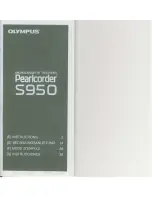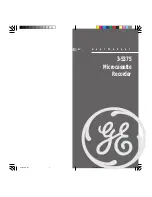
VQT4W60
93
Folder
This is a place on the hard disk, disc where groups of data are stored
together. In the case of this unit, it refers to the place where still pictures
(JPEG) and MPEG2 are stored.
Formatting
Formatting is the process of making media such as DVD-RAM
recordable on recording equipment.
You can format DVD-RAM, DVD-RW (only as DVD-Video format), +RW,
and the HDD or R and +R DL on this unit.
Formatting irrevocably erases all contents.
Frame and Field
Frame refers to the single images that constitute the video you see on
your TV. Each frame consists of 2 fields.
≥
A frame still shows 2 fields, so there may be some blurring between
them, but picture quality is generally better.
≥
A field still shows less picture information so it may be rougher, but
there is no blurring.
HDD (Hard disk drive)
This is a mass data storage device used in computers, etc. A disk with a
surface that has been treated with magnetic fluid is spun and a
magnetic head is brought in close proximity to facilitate the reading and
writing of large amounts of data at high speed.
HDMI (High-Definition Multimedia Interface)
Unlike conventional connections, it transmits uncompressed digital
video and audio signals on a single cable. This unit supports high-
definition video output [720p (750p), 1080i (1125i) and 1080p (1125p)]
from HDMI AV OUT terminal. To enjoy high-definition video a high
definition compatible television is required.
JPEG (Joint Photographic Experts Group)
This is a system used for compressing/decoding colour still pictures. If
you select JPEG as the storage system on digital cameras, etc., the
data will be compressed to 1/101/100 of its original size. The benefit of
JPEG is less deterioration in picture quality considering the degree of
compression.
LPCM (Linear PCM)
These are uncompressed digital signals, similar to those found on CDs.
MPEG2 (Moving Picture Experts Group)
A standard for efficiently compressing and expanding colour video.
MPEG2 is a compression standard used for DVD and satellite based
digital broadcasting. This unit records programmes using MPEG2.
SD Video files shot with a Panasonic SD video camera, etc. can be
copied to the HDD or a DVD-RAM disc.
MP3 (MPEG Audio Layer 3)
An audio compression method that compresses audio to approximately
1/10 of its size without any significant loss of audio quality.
Pan & Scan/Letterbox
In general, DVD-Video are produced with the intention that they will be
viewed on a widescreen TV (16:9 aspect ratio), so images often don’t fit
regular TVs (4:3 aspect ratio). 2 styles of picture, “Pan & Scan” and
“Letterbox”, deal with this problem.
Playback control (PBC)
If a Video CD has playback control, you can select scenes and
information with menus on the screen.
(This unit is compatible with version 2.0 and 1.1.)
Protection
You can prevent accidental erasure by setting writing protection or
erasure protection.
RGB
This refers to the three primary colours of light, red (R), green (G), and
blue (B) and also the method of producing video that uses them. By
dividing the video signal into the three colours for transmission, noise is
reduced for even higher quality images.
Sampling frequency
Sampling is the process of converting the heights of sound wave
(analogue signal) samples taken at set periods into digits (digital
encoding). Sampling frequency is the number of samples taken per
second, so larger numbers mean more faithful reproduction of the
original sound.
Signal Quality
This is the guide for checking the aerial direction. The numbered values
displayed do not indicate the strength of the signal, but the quality of the
signal (the signal to noise ratio, or “S/N”). The channels you can receive
are affected by weather conditions, seasons, time (day/night), region,
length of the cable that is connected to the aerial, etc.
Thumbnail
This refers to a miniature representation of a picture used to display
multiple pictures in the form of a matrix.
1080i
In one high-definition image, 1080 (1125) alternating scan lines pass
every 1/50th of a second to create an interlace image. Because 1080i
(1125i) more than doubles current television broadcasts of 480i (525i),
the detail is much clearer and creates a more realistic and rich image.
1080p
In one high-definition image, 1080 (1125) scan lines pass at the same
time every 1/50th of a second to create a progressive image. Since
progressive video does not alternate scan lines like interlace, there is a
minimal amount of screen flicker.
720p
In one high-definition image, 720 (750) scan lines pass at the same
time every 1/50th of a second to create a progressive image. Since
progressive video does not alternate scan lines like interlace, there is a
minimal amount of screen flicker.
Pan & Scan:
The sides are cut off so the picture
fills the screen.
Letterbox:
Black bands appear at the top and
bottom of the picture so the
picture itself appears in an aspect
ratio of 16:9.
Frame
Field
Field
DMR-EX86EB_VQTXXXX-B.book 93 ページ 2013年3月6日 水曜日 午後4時26分




































